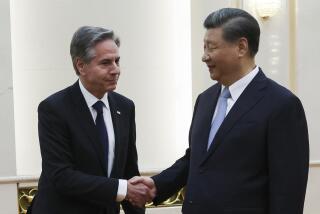Put China in an Economic Vise : Choking on Debt, Beijing Will Be Compelled to Loosen Up
- Share via
The origin of China’s student-led democratic movement can be traced to the profound and deepening political and economic crises in Chinese society. The tragic suppression of the movement has added another, more violent, dimension to these crises.
By engineering a bloody crackdown on peaceful demonstrators, the Chinese government under Deng Xiaoping has again miscalculated the risks and consequences of such an act. Deng assumed--erroneously--that the West cared more about profit than human rights, that China could still act as irresponsibly as it did under the late dictator Mao Tse-tung, and that the very structure of communism in China hadn’t changed much.
Ten years ago, Deng thought he could save the communist system by introducing only economic reforms. The result has been to irrevocably weaken communism. Now, the suppression of pro-democracy students and the regression into China’s totalitarian past have only succeeded in exacerbating the economic problems that were almost ignored during the heyday of the pro-democracy movement.
These problems, in turn, will make governing more difficult, if not impossible. Many signs indicate that it is only a matter of time before a severe economic crisis descends on China--with devastating consequences for the regime in Beijing. The arrival of this economic breakdown has already been quickened by the sanctions that Western democracies have taken--or will impose--against the Chinese government.
The depth and magnitude of this impending economic breakdown can be measured by one key index: foreign debt.
In the past 10 years, China has borrowed nearly $47 billion from the West. Although the total amount of foreign debt places China behind Brazil and Mexico, the pattern of borrowing reveals some alarming signs of structural weakness in the Chinese economy that do not bode well either for the Beijing regime or for its Western lenders.
China’s foreign debt more than doubled in the past two years. With its merchandise trade deficit last year at $7 billion and interest charges of about $3 billion a year, China needs roughly $10 billion of Western loans each year simply to stay solvent. In fact, for the past two years, China annually borrowed about that amount. China’s current account balance will deteriorate further next year when it has to start repaying the principal of the foreign loans it borrowed 10 years ago. By 1992, Chinese repayment of foreign debt will reach its peak.
Where will Beijing get so much money?
So far, it has borrowed from Peter to pay Paul. Its credit-worthiness is maintained by an infusion of new loans. China has now become the largest single borrower from the World Bank. The economic decentralization of recent years also has led to the floating of bonds by many Chinese companies on the Western financial markets and to the increasing short-term, high-interest debts owed to Western commercial banks.
The only alternative to borrowing more in order to pay off old debts is by increasing exports, reducing imports--or both. Except for South Korea, few countries have succeeded in the first strategy; the second, when it was tried in Latin America in the name of austerity, has proved to be politically impossible. The third strategy will not work in China because it has to import equipment and many critical raw materials in order to export. And the fact that China’s growing food problem compels it to gobble up grains on the world market further weakens its ability to make productive use of precious and dwindling foreign capital.
When China resorted to its own version of austerity in the early 1960s after the Sino-Soviet break and the economic version of the Beijing massacre--the Great Leap Forward--human losses were mind-boggling. More than 20 million peasants died of starvation, although Mao’s government was able to pay off several billion rubles owed to the Soviets.
The factors that made the austerity of 1960-62 possible are definitely missing this time. The relationship between the government and the people has changed into one of hatred--the party may still rule, but cannot govern. The dimensions of the economic crisis also far exceed those of the early 1960s. And China’s dependence on foreign capital and technology is much greater now than then.
In 1949, Mao could turn to the Soviet Union for help. In 1979, Deng could turn to the West. In 1989, the Chinese government cannot turn to anybody, including its own people, for life-saving assistance.
This is why economic sanctions from the West, if done collectively, will help restrain the excesses of Deng and his minions. Few regimes have the ability to repress its people when the state’s treasury is empty and there are bread riots everywhere.
In the case of China, ironically, political moderation seems to follow only economic disasters. When Deng first declared that the color of the cat doesn’t matter as long as it catches the mouse, it was in the early 1960s; when he sang it the second time at the end of the last decade, China was on the brink of total economic bankruptcy. Let us hope in a few months’ time the cat will return to pick up the pieces.
More to Read
Sign up for Essential California
The most important California stories and recommendations in your inbox every morning.
You may occasionally receive promotional content from the Los Angeles Times.













